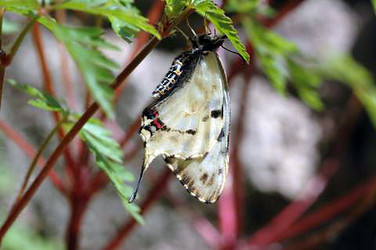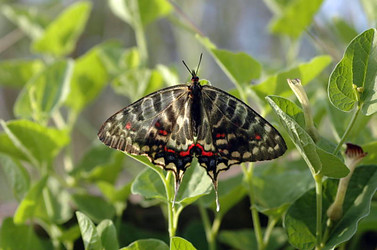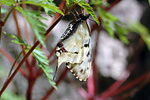Sericinus
Sericinus montela
Vazrick NazariIntroduction
The genus Sericinus (Type species by monotypy: Papilio telamon Donovan, 1798 = montela Gray, 1852) (Hemming, 1967), and its only species, S. montela, is distributed in the Russian Far East, Korea, China, and Japan (Ackery, 1975). Its larvae feed on Aristolochia, and it is the only multi-voltine species in the Parnassiinae (Igarashi 2003). The life history of this species has been studied extensively by Monastyrisky and Kotlobay (1995), Li (1983), Igarashi (1984) and Nardelli (1993). There is very little published research on other aspects of S. montela; Kwon and colleagues (1995) studied the hemocytic (blood cell) differentiation in S. montela.
Geographical Distribution
China, North and South Korea (Ackery, 1975), Vladivostok, Amur, Ussuri (Tuzov et al., 1997). It has been recently introduced to Japan (Kumon, 2005).
Geographical Variation
This is a relatively variable butterfly, and a number of subspecies are recognized (Bryk, 1934). The nominal subspecies, S. montela montela Gray, 1852 (Type locality: Shanghai; central China) flies in China (Shanghai, Peking, Lungtau, east Tien-Muschen, Mt. Paoschan [Nanking]), as well as S. Ussuri, Russia. Most other subspecies, including S. m. absurdus Bryk, 1913 (Type locality: S. Shantung, E. China), S. m. elegans Bryk, 1913 (Type locality: China), S. m. magnus Fruhstorfer, 1913 (Type locality: Kiangsi, south China), S. m. mandshuricus Rosen, 1929 (Type locality: north Manchuria, northeast China), and S. m. guangxiensis Bai and Wang, 1998 (Type locality: China) are also described from and restricted to China (Bryk, 1934; Bai and Wang, 1998). Korea has three subspecies: S. m. koreanus Fixsen, 1887 (Type locality: Korea: Seoul, Kwangnoeng), S. m. eisneri Bryk, 1932 (Type locality: North Korea: vic. Sei-shisi), and S. m. songdoi Seok, 1933 (Type locality: Songdo, Korea) (Bryk, 1934). Subspecies S. m. amurensis (Staudinger, 1892) (Type locality: Ussuri: Sudschanski Rudnik, Amur merid) is recorded from Amur, Sutchansk, and Ussuri (Bryk, 1934).
Larval Food Plant
The larvae of S. montela feed on Aristolochia contorta (Aristolochiaceae) in the wild, and on A. debilis and A. clematitis under lab conditions (Monastyrski and Kotlobay, 1995).
Nomenclature
The name Sericinus montela Gray, 1852 was proposed as a replacement for the preoccupied Papilio telamon Donovan, 1798 (preoccupied by Papilio telamon Linnaeus, 1758). P. telamon Donovan,1789 was originally designated as the type species of Sericinus (Hemming, 1967).
References
Ackery, P.R., 1975. A guide to the genera and species of Parnassiinae (Lepidoptera: Papilionidae). Bull. Br. Mus. Nat. Hist. Ent. 31: 71-105, plates 1-15.
Bai, J., Wang, X., 1998. Swallowtail butterflies in China. The Shu-Sheng Press, Taibei, China.
Bryk, F., 1934. Baroniidae, Teinopalpidae, Parnassiidae, Part.I. Das Tierreich, Deutschen Zoologische Gesellschaft im Auftrag der Preussischen Akademie der Wissensch. Berlin und Lepizig, 64: I-XXIII, 1-131.
Hemming, A.F., 1967. The generic names of the butterflies and their type-species (Lepidoptera: Rhopalocera). Bull. Br. Mus. Nat. Hist. Ent. Suppl. 9: 509 pp.
Igarashi, S., 1984. The classification of the Papilionidae mainly based on the morphology of their immature stages. Tyō to Ga 34: 41-96.
Igarashi, S., 2003. Life history of Bhutanitis mansfieldi in comparison with those of related species. Butterflies (Publication of the Butterfly Society of Japan), 35:20-39.
Kumon, T., 2005. Butterflies of Japan. Accessed December 2005.
Kwon, S.B., Huh, Y.H., Yang, H.Y., 1995. Hemocytic differentiation in Sericinus montela Grey (Lepidoptera: Papilionidae). Korean J. Zool. 38: 313-323.
Li, X.D., 1983. Scientific notes on Sericinus montela Grey. Entomological Knowledge (Kun Chong zhi shi), 20: 83-84.
Monastyrskiy, A.L., Kotlobay, A.A., 1995. Some biological features of Sericinus telamon (Papilionidae) and its rearing under laboratory conditions. Entomological Review 74: 94-97.
Nardelli, U., 1993. Bemerkungen zur Zucht einiger Zerynthiini und Parnassiini (Lepidoptera: Papilionidae). Entomologische Zeitschrift 103: 213-228.
Tuzov, V.K., Bogdanov, P.V., Devyatkin, A.L., Kaabak, L.V., Korolev, V.A., Murzin, V.S., Samodurov, G.D., Tarasov, E.A., 1997. Guide to the Butterflies of Russia and Adjacent Territories (Lepidoptera, Rhopalocera). Volume 1: Hesperiidae, Papilionidae, Pieridae, Satyridae. Pensoft Series Faunistica No 7. Sofia-Mosow. 480 pp.
About This Page
Vazrick Nazari

Canadian National Collection of Insects, Arachnids and Nematodes, Ottawa, Canada
Correspondence regarding this page should be directed to Vazrick Nazari at
Page copyright © 2006 Vazrick Nazari
 Page: Tree of Life
Sericinus . Sericinus montela .
Authored by
Vazrick Nazari.
The TEXT of this page is licensed under the
Creative Commons Attribution License - Version 3.0. Note that images and other media
featured on this page are each governed by their own license, and they may or may not be available
for reuse. Click on an image or a media link to access the media data window, which provides the
relevant licensing information. For the general terms and conditions of ToL material reuse and
redistribution, please see the Tree of Life Copyright
Policies.
Page: Tree of Life
Sericinus . Sericinus montela .
Authored by
Vazrick Nazari.
The TEXT of this page is licensed under the
Creative Commons Attribution License - Version 3.0. Note that images and other media
featured on this page are each governed by their own license, and they may or may not be available
for reuse. Click on an image or a media link to access the media data window, which provides the
relevant licensing information. For the general terms and conditions of ToL material reuse and
redistribution, please see the Tree of Life Copyright
Policies.
- First online 07 July 2006
- Content changed 07 July 2006
Citing this page:
Nazari, Vazrick. 2006. Sericinus . Sericinus montela . Version 07 July 2006 (under construction). http://tolweb.org/Sericinus_montela_/65396/2006.07.07 in The Tree of Life Web Project, http://tolweb.org/











 Go to quick links
Go to quick search
Go to navigation for this section of the ToL site
Go to detailed links for the ToL site
Go to quick links
Go to quick search
Go to navigation for this section of the ToL site
Go to detailed links for the ToL site